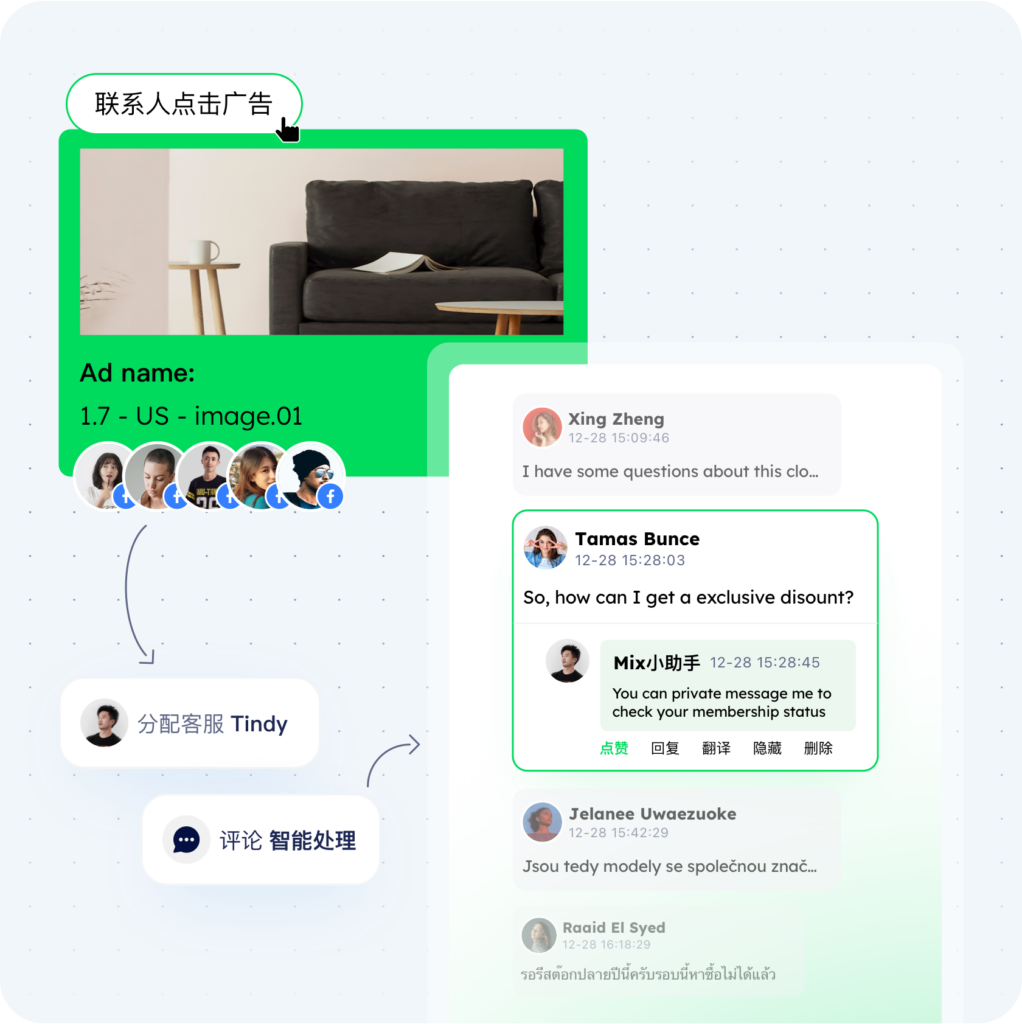Author of this article:Fiona
In digital social networking andCross-borderE-commerce in operation,Telegram Groups have become an important position for companies to communicate with customers and interact with brands. Compared with traditional one-way communication methods, Telegram groups provide real-time interaction, member autonomy, and multi-functionrobotAdvantages of support. However, as the number of group members continues to increase, problems such as management difficulty, message precipitation, and interaction rate decline have gradually become more prominent.
This article will analyze in depth how to use Mixdesk The innovative tagging system and automated reply function have transformed the Telegram group from a “taciturn” to a “dynamic community”, achieving exponential growth in interaction rate and user stickiness.
- 1. Common dilemmas and pain points of Telegram group operations
- 2. Telegram group labeling system: Refined user stratification and personalized operation
- 3. The core strategy of Telegram group operation
- 4. 4 advanced techniques for Telegram group operation: Let the effect continue to be magnified
- 5. Practical guide: Use Mixdesk to increase the interaction rate of Telegram groups
- 6. Future trend outlook: Telegram group operation and the continuous evolution of Mixdesk
1. Common dilemmas and pain points of Telegram group operations
- Management pressure caused by the expansion of the group
When the number of Telegram groups of a cross-border e-commerce company exceeded 500 people, the operation team found that less than 20% of the product recommendation messages posted every day were replied to by members, and a large number of new users quickly “dived” after joining and no longer participated in the discussion. . This is not an exception. According to industry research, more than 67% of Telegram groups will have an interaction rate below 15% after the number of members reaches 300. The core problem is that: after the member base becomes larger, the news can easily be overwhelmed, and users lack personalized attention, which leads to frustration in their enthusiasm for participation; it is difficult for operators to accurately grasp user needs, and mass content cannot arouse widespread interest; manualreplyEfficiency is low, and new user inquiries are often lost due to unresponsiveness.
- Serious information precipitation: Important announcements and event information can easily be overwhelmed in ordinary conversations, and members cannot obtain them in time.
- Interaction rate drops: There is a lack of classification guidance for new members after joining, so it is easy to just be a spectator and not participate in discussions or interactions.
- Increased management complexity: Administrators need to spend a lot of time reviewing messages, replying to member questions, reviewing content, and manuallycostrise.

- Diversification of member needs
In terms of content dissemination, a technology Telegram group tried to push 3 industry information every day, but the open rate of its members was less than 30%, and there were few comments. The reason is the lack of an effective content filtering and pushing mechanism, and the failure to hierarchical push based on user interests, which makes the information seriously disconnected from user needs. At the same time, advertisements and spam messages in the group appear from time to time, interfering with normal communication, and manual cleanup by operators is time-consuming and laborious, and it is difficult to cure. In addition, the interests, purchasing intentions, and activity of group members vary:
- Potential customersHope to obtain product information or promotions.
- Old customersPay attention to after-sales support and experience sharing.
- Active participantsHope to obtain privileged content or reward mechanisms.
It is difficult for traditional group operation methods to meet the needs of multiple types of members at the same time, and the homogenization of information is serious, resulting in a decrease in interaction rate. The above pain points have seriously restricted the operational effectiveness of the Telegram group, and an efficient solution is urgently needed.
2. Telegram group labeling system: Refined user stratification and personalized operation
To solve these pain points, the core idea lies inLet every member of the group be "seen”, Rather than being generally classified as a large group. This requires the introduction of Labeling system To perform hierarchical management of users. With the help of Mixdesk And other intelligent tools, operators can chat privately between customers and customer service in the first time, according to their source channels (such as advertising, social media recommendations, organic traffic), interactive behavior (whether they have consulted the price, whether they have clicked on a specific link), purchase stage (potential customers, first-time order users, old customers).) and other dimensions, accurately label each customer. In this way, the original disordered group members can be quickly classified into categories, forming a clear structured user pool.
With a labeling system in place, group operations can realize ”the right medicine"-style content delivery.:
- Basic announcements or important event information can cover all users to ensure that no one misses key news;
- For users who frequently consult prices and show strong purchasing intentions, limited-time offers and promotions can be targeted to increase conversion rates.;
- For old customers, focus on after-sales service guidelines, usage skills, and exclusive community benefits to enhance loyalty and repurchase rates.;
- For highly active group members, you can push additional exclusive event invitations or points rewards to further enhance their enthusiasm for participation and sense of belonging.

This kind of Refined label operation It can effectively avoid the information noise caused by ”pan-mass distribution", so that different user groups can receive the most relevant content at the right time. As a result, the overall interaction rate of the group has increased significantly, the viscosity of members to the group has increased, and the customer value has also increased. It can be said that the labeling system is the infrastructure for the refined operation of Telegram groups. It can not only help operators save a lot of moneyLabor management costs, It can also make the group truly become an efficient, orderly, and sustainable growth private domain position, rather than the superficial prosperity of “many people but silent”.
and Scientific user label classification method It is a prerequisite for achieving refined management. The rapid division of levels among complex customer groups lays the foundation for subsequent targeted communication and personalized push. Common classification methods include:
- Customer life cycle dimension: Such as new customers, potential customers, repurchase customers, VIP members, suppliers, etc., to help companies distinguish members at different value stages.
- Interests and product preferences: Through users' questions in private chats, form choices, or customer service records, identify their attention to different categories such as electronic products, fashion clothing, beauty and skin care, and their preferences for content types (evaluation, teaching, promotion).
- Purchase stage label: Make judgments based on the keywords or behaviors that appear in the user's dialogue. For example, “I want to place an order” can be classified as the intended customer, “Paid” is the purchased customer, and “Return and exchange” corresponds to the after-sales process.
- Behavioral activity: Automatically mark according to the user's interaction frequency within a certain period of time, such as high-frequency consultants, recently active members, or “sleeping customers” who have not responded for a long time.
- Geographic location and language: Based on the user's IP, time zone, or language selected in the first conversation, it is marked as “local customer”, “Middle East customer”, etc., to facilitate subsequent sending of localized activity information and regular mass distribution of content.
- Source channel: Combined with the information disclosed in the private chat or buried tracking, mark customers from advertising (such as Facebook Ads, Google Ads), organic traffic, or community recommendations, so that operators can distinguish channel effectiveness in the future.
Through the flexible combination of these dimensions, enterprises can quickly build a set of "Traceable, layered, iterable” The user portrait system. For example, a female user who has come from Facebook ads and has recently frequently consulted beauty products in private chats can be labeled as a composite label of “potential customers + beauty preferences + high-frequency consultants + Facebook channels” at the same time. Such a refined classification not only allows operators to better understand user needs, but also realizes “thousands of people and thousands of faces” in targeted mass distribution and customer service strategies, significantly improving the interaction rate and conversion effect.
3. The core strategy of Telegram group operation
Efficient operation of Telegram groups requires enterprises to form a closed loop in the three aspects of “precise management, automated response, and data-driven optimization” in order to maintain a high interaction rate and conversion effect while the scale of members continues to expand and the needs are diversified. The core strategies include:
- Precise labeling management

Through a standardized labeling system, enterprises can carry out multi-dimensional classification according to members' interests, preferences, activity, purchase stage, geographical location and source channels, and realize refined management. Labeling can not only help operators quickly identify new customers, potential customers, and old customers, but also improve information matching in mass distribution, targeted push, or personalized activities. For example, mark active users as “highly interactive members” and long-term unresponsive users as “sleeping members” to facilitate subsequent awakening or rewards through different strategies. Through labeling management, group operations have changed from blind push toPrecise force, Effectively improve the message opening rate and participation.
- Automated message processing
For high-frequency and repetitive problems in daily operations, manual response is not only time-consuming, but also prone to omissions. With the help ofAI AgentSet upAutomated replyRules, when customers send frequently asked questions or specific keywords, the system will automatically trigger preset answers or guide them to the corresponding resource page. Automation not only improves response speed, but also ensures consistent information transmission. For example, if a user asks “logistics progress” or “product usage method”, the system can immediately return standardized answers, while recording user behavior to update the label, and realize the closed-loop management of “intelligent learning + automatic response”. The implementation of automation allows the operation team to focus more energy on high-value users or personalized services, saving a lot of labor costs.
- Data-driven optimization
The success of Telegram group operations is inseparable from continuous data analysis and feedback. Operators can pass AI Agent Count real-time data to form quantifiable operational indicators. Based on data insights, operators can optimize message delivery time, content format, and interaction strategies for different tag groups. The data-driven strategy enables Telegram group operations to not only have a direction to follow, but also to be continuously optimized iteratively to form a refined and intelligent long-term operation system.
4. 4 advanced techniques for Telegram group operation: Let the effect continue to be magnified
1. Automated user label management
With the help of Mixdesk, Enterprises can implement user tags in Telegram groupsautomaticChemical management. For example, the system can automatically trigger a welcome message in the corresponding language based on the user's IP or the source channel of the first conversation, creating a first impression that fits the user's habits. At the same time,Mixdesk Support labeling users according to multiple dimensions such as “customer source”, “consultation type”, “purchase stage”, etc., to help operators quickly distinguish between new customers, potential customers and old customers. So that enterprises can not only conduct accurate follow-up communication, but also ensure a higher degree of content matching when sending in bulk or targeted push, greatly improving the operational efficiency and interaction quality of Telegram groups.
2. Combining "automation + manual interaction”
use Mixdesk, Enterprises can customize rules for high-frequency business scenarios, combine quick response with AI capabilities, and build a full processAutomated responselogic. Automated replies solve 80% of duplicate problems, and manually focus on “high-value users”. Realize the efficient model of "automatically solving basic needs and manually focusing on high-value services".
4. Synchronous operation across platforms
If you operate Facebook, Instagram and other platforms at the same time, you can pass Mixdesk Synchronize and aggregate accounts of other platforms to achieve "unified and accurate operation of all channels".
5. Test different automation rules
Do A/B testing of the "Welcome message for new customers": version A pushes “Receive information", version B pushes “Participate in the lucky Draw", pass Mixdesk backstagedataKanban compares the number of effective conversations and satisfaction between the two, and selects the best solution.
5. Practical guide: Use Mixdesk to increase the interaction rate of Telegram groups
- Establish a labeling system: First establish basic labels based on customer sources, dialogue content, etc.
- Set automation rules: Design an automatic response process for frequently asked questions, event notifications, etc.
- Regularly resubmit data: Optimize labeling and automation strategies based on data such as customer service activity and message response rate.
- Refined and layered mass distribution: Push information accurately according to the label to avoid mass complaints.
- Continuously optimize content: Adjust the content type, push time and interaction strategy based on the data analysis results.
6. Future trend outlook: Telegram group operation and the continuous evolution of Mixdesk
The core of the operation of the Telegram group lies in “delivering the right content to the right people at the right time.”Mixdesk A labeling system that helps companies build helps operators accurately identify and segment group users, and clarify “who is the right person and what they really need”; automated responses solve the problem of “how to reach efficiently”, making interactions more immediate and targeted. The combination of the two has upgraded group operations from “blind trial and error” in the past to “data-driven precision”.
Looking to the future, the operating trend of Telegram groups must be more intelligent and refined. Whoever can achieve accurate communication faster will be able to take the initiative. Access now Mixdesk, Start by labeling existing users with appropriate tags and setting up the first automated reply, so that your Telegram group can truly grow into a high-viscosity and high-conversion private domain core position.

Mixdesk is an overseas multi-channel intelligent customer communication platform that can unify multiple channels such as Facebook, Instagram, WhatsApp, Line, Telegram, and Email to help companies communicate and serve customers. Mixdesk also supports AI employee functions, allowing enterprises to achieve more efficient automated customer service.
